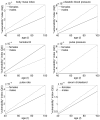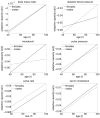Age trajectories of physiological indices in relation to healthy life course
- PMID: 21262255
- PMCID: PMC3064744
- DOI: 10.1016/j.mad.2011.01.001
Age trajectories of physiological indices in relation to healthy life course
Abstract
We analysed relationship between the risk of onset of "unhealthy life" (defined as the onset of cancer, cardiovascular diseases, or diabetes) and longitudinal changes in body mass index, diastolic blood pressure, hematocrit, pulse pressure, pulse rate, and serum cholesterol in the Framingham Heart Study (Original Cohort) using the stochastic process model of human mortality and aging. The analyses demonstrate how decline in resistance to stresses and adaptive capacity accompanying human aging can be evaluated from longitudinal data. We showed how these components of the aging process, as well as deviation of the trajectories of physiological indices from those minimising the risk at respective ages, can lead to an increase in the risk of onset of unhealthy life with age. The results indicate the presence of substantial gender difference in aging related decline in stress resistance and adaptive capacity, which can contribute to differences in the shape of the sex-specific patterns of incidence rates of aging related diseases.
Copyright © 2011 Elsevier Ireland Ltd. All rights reserved.
Figures






References
-
- Allison DB, Faith MS, Heo M, Kotler DP. Hypothesis concerning the U-shaped relation between body mass index and mortality. Am. J. Epidemiol. 1997;146(4):339–349. - PubMed
-
- Arbeev KG, Ukraintseva SV, Arbeeva LS, Yashin AI. Mathematical models for human cancer incidence rates. Demographic Research. 2005;12(10):237–271.
-
- Bagdonavicius V, Nikulin M. Statistical Models to Analyze Failure, Wear, Fatigue, and Degradation Data with Explanatory Variables. Communications in Statistics - Theory and Methods. 2009;38(16-17):3031–3047.
-
- Boutitie F, Gueyffier F, Pocock S, Fagard R, Boissel JP. J-shaped relationship between blood pressure and mortality in hypertensive patients: New insights from a meta-analysis of individual-patient data. Ann. Intern. Med. 2002;136(6):438–448. - PubMed
Publication types
MeSH terms
Grants and funding
LinkOut - more resources
Full Text Sources
Medical

